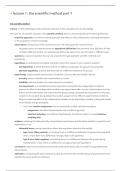● lecture 1: the scientific method part 1
the scientific method
science, a methodolological and systematic approach to the acquisition of new knowledge
the basis for all scientific research is the scientific method, which is characterized by the following elements:
– empirical approach, an evidence-based approach that relies on direct observation and experimentation
in the acquisition of new knowledge
– observations, being aware of the world around us and making careful measurements
– important aspect of measurements are operational definitions that provide a clear definition for key
concepts, different studies can operationally define the same terms and concepts in different ways
– questions, a research question that can be answered through available scientific methods and
procedures.
– hypotheses, an educated and testable prediction about the answer to your research question
– null hypothesis, predicts that there will be no differences between the groups being studied
– alternate hypothesis, predicts that there will be a difference between the groups
– experiments, measuring the phenomenon of interest in an accurate and reliable manner
– accuracy, refers to whether the measurement is correct
– reliability, refers to whether the measurement is consistent
– true experiment, a controlled test where researchers manipulate the independent variable to
observe its effect on the dependent variable. true experiments often involve randomization as a key
feature to eliminate biases and ensure that the groups being compared are equivalent in every way
except for the variable being tested. this random assignment to different experimental conditions
helps to isolate the effect of the independent variable on the dependent variable, making the results
more reliable and generalizable.
– must have random assignment, but not necessarily random selection/sampling
– assignment: allocation of participants into conditions (groups)
– selection/sampling: recruitment of participants, should be random to avoid selection/
sampling bias
– analyses, analyzing the data generally using statistical techniques and deciding whether to reject the null
hypotheses or not
– inferential errors, wrong conclusions about the population based on the sample
– type I error (false positive), concluding there is a difference between the groups being studied
when, in fact, there is no difference; wrongly reject null hypothesis
– type II error (false negative), concluding there is no difference between the groups being
studied when, in fact, there is a difference; wrongly accept null hypothesis
– conclusions, draw some conclusions about the results of the study, which should be supported by the
data analyses
– replication, conducting the same research study a second time with another group of participants to see
whether the same results are obtained
, – the results of the original study should be generalizable; the sample has to be representative of our
population of interest
properties of the scientific method
– systematic observation, the emperical approach; valid and accurate data
– rigorous thought, careful interpretation of the data
important concepts in the scientific method
– qualitative research vs quantative research
– qualitative research, observations without measurement, like interviews and case studies
– quantative research, formal measurements with statistical analyses, repeated observations
– experimental research vs correlational research
– experimental research, some form of manipulation by the researcher; independent variable is
manipulated
– true experiment, manipulation is random
– correlational research, examine relationship between naturally occurring variables.
– dependent variables vs independent variables
– variables, varying quantities for which we want to understand their relationship
– we want to understand the effect that an independent variable has on a dependent variable
– correlational relationship vs causal relationship
– correlational relationship, a relationship between two variables , does not imply causation
– positive correlation, both variables change in the same direction; so they both increase or
decrease
– negative (inverse) correlation, if one variable increases, the other decreases
– causal relationship, whether a change in the in the independent variable cause a change in the
dependent variable, only true experiments allow us to make causal claims; by randomly variation of
the independent variable any additional factors get filtered out.
– if experiment shows significant results, and it is a true experiment, we can conclude that the
independent variable affects the dependent variable
– sample vs population
– population, all individuals of interest to the researcher
– sample, a subset of the population which researches typically use in their study
cognitive biases that occur in the process of scientific method
– availability bias, the tendency to overestimate the likelihood of events with greater "availability" in
memory
– irrational/emotional bias, the tendency to let one's mood and current situation dictate their perspective
on certain situations






